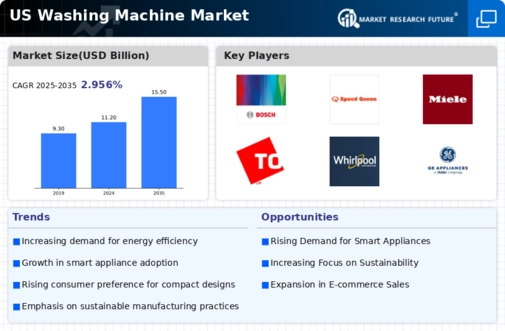Urbanization Trends
Urbanization trends significantly impact the washing machine market, particularly in metropolitan areas where space is limited. As more individuals and families move to cities, the demand for compact and multifunctional appliances rises. In 2025, approximately 60% of new washing machine sales are projected to be for space-saving models designed for urban living. This trend compels manufacturers to focus on creating machines that are not only efficient but also fit seamlessly into smaller living spaces. The washing machine market must adapt to these changing consumer needs, leading to innovations in design and functionality.
Sustainability Initiatives
The washing machine market is increasingly influenced by sustainability initiatives as consumers become more environmentally conscious. Manufacturers are responding by developing energy-efficient models that consume less water and electricity. In 2025, it is estimated that around 30% of washing machines sold in the US will meet stringent energy efficiency standards set by the Department of Energy. This shift not only reduces the carbon footprint but also appeals to eco-friendly consumers, driving demand for sustainable products. The washing machine market is thus witnessing a transformation where sustainability is a key selling point, encouraging brands to innovate and invest in greener technologies.
Technological Advancements
Technological advancements play a crucial role in shaping the washing machine market. Innovations such as smart connectivity, AI-driven features, and advanced washing technologies are becoming standard in new models. By 2025, it is anticipated that over 40% of washing machines sold will incorporate smart technology, allowing users to control their appliances remotely and receive maintenance alerts. This trend enhances user convenience and efficiency, making the washing machine market more competitive. As technology continues to evolve, manufacturers are likely to invest heavily in R&D to stay ahead of consumer expectations.
Consumer Preferences for Convenience
Consumer preferences for convenience are driving changes in the washing machine market. Busy lifestyles lead to a growing demand for machines that offer quick wash cycles, self-cleaning features, and easy-to-use interfaces. In 2025, it is expected that around 50% of consumers will prioritize these convenience features when purchasing a washing machine. This shift compels manufacturers to innovate and enhance user experience, ensuring that their products meet the evolving needs of modern households. The washing machine market must remain agile to adapt to these preferences, which could dictate future product development.
Economic Factors and Disposable Income
Economic factors, particularly disposable income levels, significantly influence the washing machine market. As the economy improves, consumers are more likely to invest in higher-end models with advanced features. In 2025, it is projected that the average selling price of washing machines will increase by 10% due to rising demand for premium products. This trend suggests that the washing machine market may see a shift towards more luxurious offerings, as consumers seek appliances that provide enhanced performance and aesthetics. Manufacturers must navigate these economic conditions to align their product strategies with consumer spending habits.
























Leave a Comment